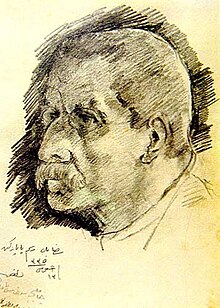Hoca Ali Rıza
Hoca Ali Rıza (* 1858 in Üsküdar , Istanbul ; † March 20, 1930 ibid) was a Turkish painter and art educator who was best known for his impressionist landscapes and cityscapes.
Life
Rıza's father was a cavalry major . After his school education he attended the Kuleli Askerî Lisesi and then the Ottoman Military Academy , where he studied art with Osman Nuri and Suleyman Seyyid . In 1881 he received an award from Sultan Abdülhamid II for his achievements in the painting class . Since the students were not allowed to practice on a living model, landscape depiction was particularly popular. In 1884 he finished his training as a lieutenant and became Nuri's assistant. Rıza actually wanted to continue his studies in Naples, but had to give up his plans because a cholera epidemic had broken out in southern Italy .

In 1891 Rıza became a member of a commission for the assessment of Turkish-Islamic artifacts from the first Ottoman capital. Four years later he was promoted to Kolağası ( Major ) and he became a designer in the new Imperial Porcelain Manufactory . He also worked with Fausto Zonaro , who worked as an art teacher at Yıldız Palace .
During the Greco-Turkish War , the artist worked as a battle painter in Ionia . In 1903 he was a member of a commission for the establishment of the antique museum "Türk Esliha-i Antika Müzesi". Six years later he became the chief painter in the military printing house, where he worked for two years. From 1909 to 1912 he was also chairman of the "Ottoman Painters' Association". In 1911 he retired as Yarbay ( lieutenant colonel ).
From 1914 he taught at the Academy of Fine Arts (today Mimar Sinan Üniversitesi ). After savings from the Ministry of Education, he went to a secondary school for girls in Istanbul's Çamlıca district as a painting teacher for three years . He then taught at an art school for girls in Üsküdar and from 1929 at the Sultan Ahmed School for boys.
His last exhibition during his lifetime was organized by the painter and MP Celal Esat Arseven in Paris in 1928. Rıza's work remained important in the young Republic of Turkey and was shown in numerous exhibitions. In 1933 the Halkevi in Ankara showed its work in the organization's first exhibition. 16 other solo exhibitions followed, which cemented his reputation as an important landscape painter in Turkey.
Ali Rıza was married to Nadide Hanım. The couple had three daughters and one son.
literature
- Nurullah Berk: Hoca Ali Rıza'nın Sanatı . In: Arkitekt Dergisi Sayı , No. 298, 1960
- Ömer Faruk Şerifoğlu: Hoca Ali Rıza, 1858-1930 . (= Türk Ressamları Dizisi , Volume 9), Yapı Kredi Yayınları, 2005, ISBN 975-08-0996-3
- Atila Taşpınar: Hoca Ali Rıza Bey . Boyut Yayın Grubu, 2012, ISBN 978-975-230-982-1
- Wendy MK Shaw: Ottoman Painting: Reflections of Western Art from the Ottoman Empire to the Turkish Republic . IB Tauris, London / New York 2011, pp. 91-100
Web links
- Masterpieces by Hoca Ali Rıza , Sanal Müze (Virtual Museum)
- Painting by Hoca Ali Rıza , turkishpaintings.com (Turkish)
- Hoca Ali Rıza in the Türkiye Diyanet Vakfı İslâm Ansiklopedisi (Turkish)
Individual evidence
- ↑ a b Biography in the blog of the daily Milliyet , August 22, 2009
- ↑ a b biography at the Turkish Cultural Foundation, accessed on March 21, 2017
- ↑ Shaw (2011), p. 92
| personal data | |
|---|---|
| SURNAME | Ali Rıza, Hoca |
| BRIEF DESCRIPTION | Turkish painter |
| DATE OF BIRTH | 1858 |
| PLACE OF BIRTH | Üsküdar , Istanbul |
| DATE OF DEATH | March 20, 1930 |
| Place of death | Üsküdar , Istanbul |

